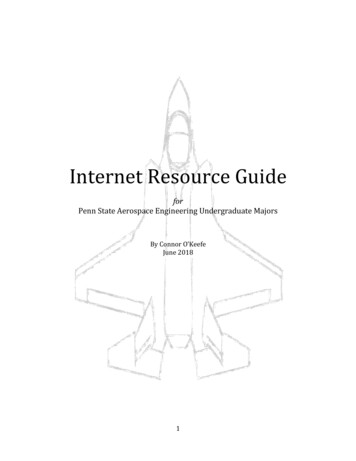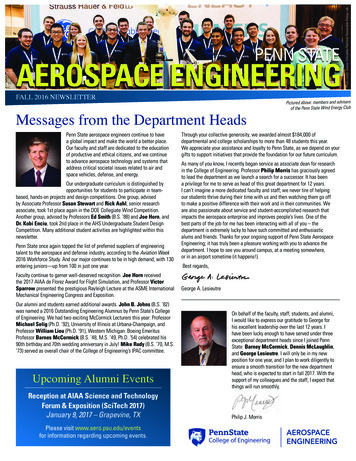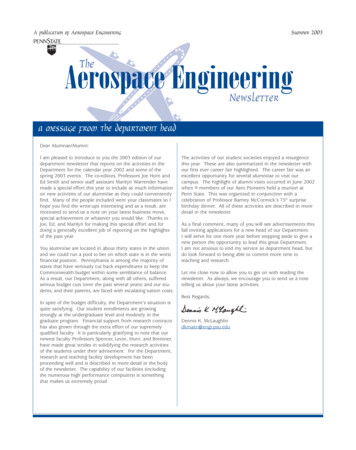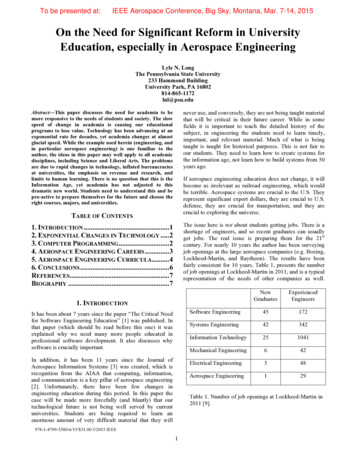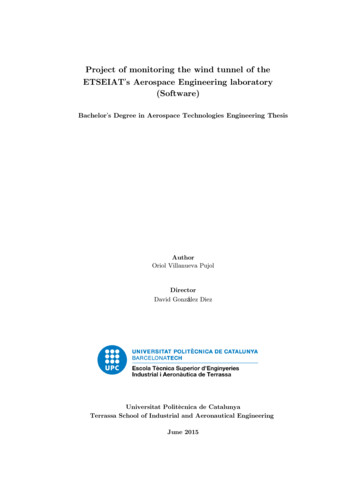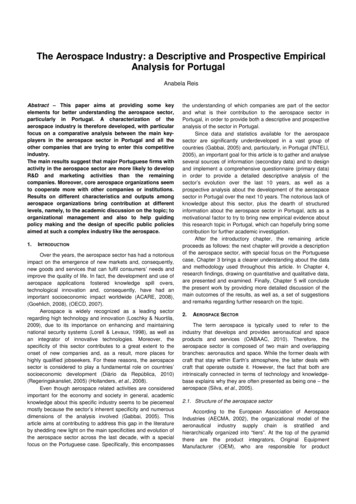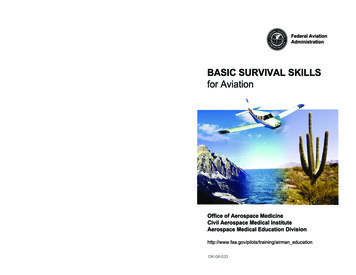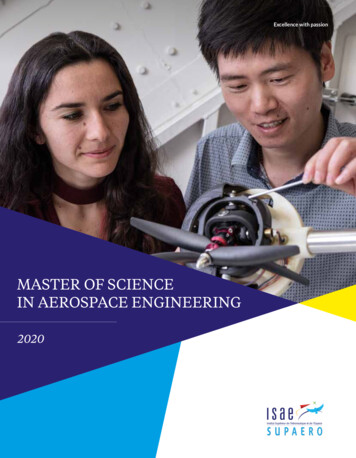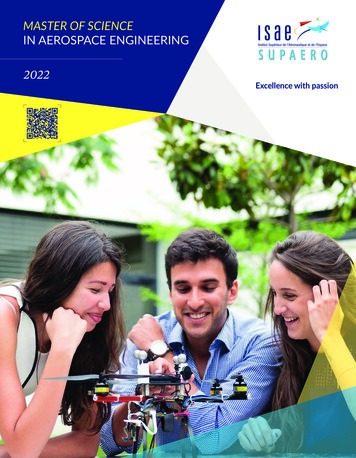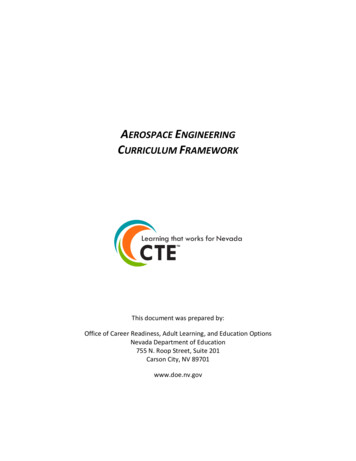
Transcription
AEROSPACE ENGINEERINGCURRICULUM FRAMEWORKThis document was prepared by:Office of Career Readiness, Adult Learning, and Education OptionsNevada Department of Education755 N. Roop Street, Suite 201Carson City, NV 89701www.doe.nv.gov
NEVADA CTE CURRICULUM FRAMEWORK2013NEVADA STATE BOARD OF EDUCATIONFelicia Ortiz . PresidentMark Newburn . Vice PresidentRené Cantú. MemberKatie Coombs . MemberKatherine Dockweiler. MemberTamara Hudson . MemberTim Hughes . MemberCathy McAdoo . MemberMike Walker . MemberWayne Workman . MemberAlex Gallegos . Student RepresentativeNEVADA DEPARTMENT OF EDUCATIONJhone M. EbertSuperintendent of Public InstructionCraig Statucki, DirectorOffice of Career Readiness, Adult Learning, and Education OptionsVISIONAll Nevadans ready for success in the 21st centuryMISSIONTo improve student achievement and educator effectiveness by ensuring opportunities,facilitating learning, and promoting excellenceRevised: 04/15/2021Aerospace Engineering2
NEVADA CTE CURRICULUM FRAMEWORK2013INTRODUCTIONThe Nevada CTE Curriculum Frameworks are a resource for Nevada’s public and charter schools to design,implement, and assess their CTE programs and curriculum. The content standards identified in thisdocument are listed as a model for the development of local district programs and curriculum. Theyrepresent rigorous and relevant expectations for student performance, knowledge, and skill attainmentwhich have been validated by industry representatives.The intent of this document is to provide a resource to districts as they develop and implement CTEprograms and curricula.This program ensures the following thresholds are met: The CTE course and course sequence teaches the knowledge and skills required by industrythrough applied learning methodology and, where appropriate, work-based learning experiencesthat prepare students for careers in high-wage, high-skill, or in-demand fields. Regional and stateeconomic development priorities shall play an important role in determining program approval.Some courses also provide instruction focused on personal development. The CTE course and course sequence includes leadership and employability skills as an integralpart of the curriculum. The CTE course and course sequence is part of a rigorous program of study and includes sufficienttechnical challenge to meet state and/or industry-standards.The CTE program components include the following items: Program of Study State Skill Standards Employability Skills for Career Readiness Standards Career Technical Student Organizations (CTSOs) Curriculum Framework CTE Assessments: Workplace Readiness Skills Assessment End-of-Program Technical Assessment Certificate of Skill Attainment CTE Endorsement on a High School Diploma CTE College CreditRevised: 04/15/2021Aerospace Engineering3
NEVADA CTE CURRICULUM FRAMEWORK2013NEVADA DEPARTMENT OF EDUCATIONCURRICULUM FRAMEWORK FORAEROSPACE ENGINEERINGPROGRAM INFORMATIONProgram Title:State Skill Standards:Standards Reference Code:Career Cluster:Career Pathway:Program Length:Program Assessments:Aerospace EngineeringAerospace EngineeringAEENGScience, Technology, Engineering, and MathematicsEngineering and Technology3 Levels (L1, L2, L3C)Aerospace EngineeringWorkplace Readiness SkillsCTSO: SkillsUSAGrade Level: 9-12Industry Certifications: See Nevada’s Approved Certification ListingPROGRAM PURPOSEThe purpose of this program is to prepare students for postsecondary education and employment inthe Aerospace Engineering industry.The program includes the following state standards: Nevada CTE Skill Standards: Aerospace EngineeringEmployability Skills for Career ReadinessNevada Academic Content Standards (alignment shown in the Nevada CTE Skill Standards): English Language Arts Mathematics ScienceCommon Career Technical Core (alignment shown in the Nevada CTE Skill Standards)CAREER CLUSTERSThe National Career Clusters Framework provides a vital structure for organizing and deliveringquality CTE programs through learning and comprehensive programs of study (POS). In total, thereare 16 Career Clusters in the National Career Clusters Framework, representing more than 79 CareerPathways to help students navigate their way to greater success in college and career. As an organizingtool for curriculum design and instruction, Career Clusters provide the essential knowledge and skillsfor the 16 Career Clusters and their Career Pathways.**Cite: National Association of State Directors of Career Technical Education Consortium. (2012).Retrieved from eerClustersPathways.pdfand s.pdfRevised: 04/15/2021Aerospace Engineering4
NEVADA CTE CURRICULUM FRAMEWORK2013PROGRAM OF STUDYThe program of study illustrates the sequence of academic and career and technical educationcoursework that is necessary for the student to successfully transition into postsecondary educationalopportunities and employment in their chosen career path. (NAC 389.803)PROGRAM STRUCTUREThe core course sequencing provided in the following table serves as a guide to schools for theirprograms of study. Each course is listed in the order in which it should be taught and has a designatedlevel. Complete program sequences are essential for the successful delivery of all state standards ineach program area.AEROSPACE ENGINEERINGCore Course SequenceCOURSE NAMELEVELIntroduction to Engineering DesignL1Principles of EngineeringL2Aerospace EngineeringL3CThe core course sequencing with the complementary courses provided in the following table servesas a guide to schools for their programs of study. Each course is listed in the order in which it shouldbe taught and has a designated level. A program does not have to utilize all of the complementarycourses in order for their students to complete their program of study. Complete program sequencesare essential for the successful delivery of all state standards in each program area.AEROSPACE ENGINEERINGCore Course Sequence with Complementary CoursesCOURSE NAMELEVELIntroduction to Engineering DesignL1Principles of EngineeringL2Aerospace EngineeringL3CEngineering Design and Development*ASCTE Work Experience – Science, Technology, Engineering,and Mathematics**Complementary CoursesRevised: 04/15/2021Aerospace EngineeringWK5
NEVADA CTE CURRICULUM FRAMEWORK2013STATE SKILL STANDARDSThe state skill standards are designed to clearly state what the student should know and be able todo upon completion of an advanced high school career and technical education (CTE) program. Thestandards are designed for the student to complete all standards through their completion of aprogram of study. The standards are designed to prepare the student for the end-of-programtechnical assessment directly aligned to the standards. (Paragraph (a) of Subsection 1 of NAC 389.800)EMPLOYABILITY SKILLS FOR CAREER READINESS STANDARDSEmployability skills, often referred to as “soft skills,” have for many years been a recognizablecomponent of the standards and curriculum in career and technical education programs. The twentyone standards are organized into three areas: (1) Personal Qualities and People Skills; (2) ProfessionalKnowledge and Skills; and (3) Technology Knowledge and Skills. The standards are designed to ensurestudents graduate high school properly prepared with skills employers prioritize as the mostimportant. Instruction on all twenty-one standards must be part of each course of the CTE program.(Paragraph (d) of Subsection 1 of NAC 389.800)CURRICULUM FRAMEWORKThe Nevada CTE Curriculum Frameworks are organized utilizing the recommended course sequencinglisted in the program of study and the CTE Course Catalog. The framework identifies therecommended content standards, performance standards, and performance indicators that shouldbe taught in each course.CAREER AND TECHNICAL STUDENT ORGANIZATIONS (CTSOS)To further the development of leadership and technical skills, students must have opportunities toparticipate in one or more of the Career and Technical Student Organizations (CTSOs). CTSOs developcharacter, citizenship, and the technical, leadership and teamwork skills essential for the workforceand their further education. Their activities are considered a part of the instructional day when theyare directly related to the competencies and objectives in the course. (Paragraph (a) of Subsection 3of NAC 389.800)WORKPLACE READINESS SKILLS ASSESSMENTThe Workplace Readiness Skills Assessment has been developed to align with the Nevada CTEEmployability Skills for Career Readiness Standards. This assessment provides a measurement ofstudent employability skills attainment. Students who complete a program will be assessed on theirskill attainment during the completion level course. Completion level courses are identified by theletter “C”. (e.g., Level L3C) (Paragraph (d) of Subsection 1 of NAC 389.800)END-OF-PROGRAM TECHNICAL ASSESSMENTAn end-of-program technical assessment has been developed to align with the Nevada CTE SkillStandards for this program. This assessment provides a measurement of student technical skillattainment. Students who complete a program will be assessed on their skill attainment during thecompletion level course. Completion level courses are identified by the letter “C”. (e.g., Level L3C)(Paragraph (e) of Subsection 1 of NAC 389.800)Revised: 04/15/2021Aerospace Engineering6
NEVADA CTE CURRICULUM FRAMEWORK2013CERTIFICATE OF SKILL ATTAINMENTEach student who completes a course of study must be awarded a certificate which states that theyhave attained specific skills in the industry being studied and meets the following criteria: A studentmust maintain a 3.0 grade point average in their approved course of study, pass the WorkplaceReadiness Skills Assessment, and pass the end-of-program technical assessment. (Subsection 4 of NAC389.800)CTE ENDORSEMENT ON A HIGH SCHOOL DIPLOMAA student qualifies for a CTE endorsement on their high school diploma after successfully completingthe following criteria: (1) completion of a CTE course of study in a program area; (2) completion ofacademic requirements governing receipt of a standard diploma; and (3) meet all requirements forthe issuance of the Certificate of Skill Attainment. (NAC 389.815)CTE COLLEGE CREDITCTE College Credit is awarded to students based on articulation agreements established by eachcollege for the CTE program, where the colleges will determine the credit value of a full high schoolCTE program based on course alignment. An articulation agreement will be established for each CTEprogram designating the number of articulated credits each college will award to students whocomplete the program.CTE College Credit is awarded to students who: (1) complete the CTE course sequence with a gradepoint average of 3.0 or higher; (2) pass the state end-of-program technical assessment for theprogram; and (3) pass the Workplace Readiness Assessment for employability skills.Pre-existing articulation agreements will be recognized until new agreements are establishedaccording to current state policy and the criteria shown above.Please refer to the local high school’s course catalog or contact the local high school counselor formore information. (Paragraph (b) of Subsection 3 of NAC 389.800)ACADEMIC CREDIT FOR CTE COURSEWORKCareer and technical education courses meet the credit requirements for high school graduation (1unit of arts and humanities or career and technical education). Some career and technical educationcourses meet academic credit for high school graduation. Please refer to the local high school’s coursecatalog or contact the local high school counselor for more information. (NAC 389.672)Revised: 04/15/2021Aerospace Engineering7
NEVADA CTE CURRICULUM FRAMEWORK2013CORE COURSE(S)RECOMMENDED STUDENT PERFORMANCE STANDARDSCOURSE INFORMATIONCOURSE TITLE:ABBR. NAME:CREDITS:LEVEL:CIP CODE:SCED CODE:PREREQUISITE:CTSO:Introduction to Engineering DesignENG DESG1L114.010121017NONESkillsUSACOURSE DESCRIPTIONThis course is the entry-level course of the Engineering curriculum. The major focus of IED is the design processand its application. Through hands-on projects, students apply engineering standards and document theirwork. Students use industry-standard 3D modeling software to help them design solutions to solve proposedproblems, document their work using an engineer’s notebook, and communicate solutions to peers andmembers of the professional community.TECHNICAL STANDARDSCONTENT STANDARD 1.0: IDENTIFY LAB ORGANIZATION AND SAFETY PROCEDURESPerformance Standard 1.1: Demonstrate General Lab Safety Rules and ProceduresPerformance Indicators: 1.1.1-1.1.19Performance Standard 1.2: Identify and Utilize Hand ToolsPerformance Indicators: 1.2.1-1.2.5Performance Standard 1.3: Identify and Utilize Power Tools and EquipmentPerformance Indicators: 1.3.1-1.3.5CONTENT STANDARD 2.0: ASSESS THE IMPACT OF ENGINEERING ON SOCIETYPerformance Standard 2.1: Describe History of EngineeringPerformance Indicators: 2.1.1-2.1.4Performance Standard 2.2: Investigate Related Careers in EngineeringPerformance Indicators: 2.2.1-2.2.4Performance Standard 2.3: Analyze Ethics in EngineeringPerformance Indicators: 2.3.1-2.3.4CONTENT STANDARD 3.0: ANALYZE THE ENGINEERING DESIGN PROCESSPerformance Standard 3.1: Interpret the Engineering Design ProcessPerformance Indicators: 3.1.1-3.1.5CONTENT STANDARD 4.0: CONSTRUCT ENGINEERING DOCUMENTATIONPerformance Standard 4.1: Demonstrate Freehand Technical Sketching TechniquesPerformance Indicators: 4.1.1-4.1.6 . continue on next pageRevised: 04/15/2021Aerospace Engineering8
NEVADA CTE CURRICULUM FRAMEWORK2013Performance Standard 4.2: Demonstrate Measuring and Scaling TechniquesPerformance Indicators: 4.2.1-4.2.6Performance Standard 4.3: Utilize Engineering Documentation ProceduresPerformance Indicators: 4.3.1-4.3.4Performance Standard 4.4: Produce Technical DrawingsPerformance Indicators: 4.4.1-4.4.8Performance Standard 4.5: Demonstrate Modeling TechniquesPerformance Indicators: 4.5.1-4.5.4EMPLOYABILITY SKILLS FOR CAREER READINESS STANDARDSCONTENT STANDARD 1.0: DEMONSTRATE EMPLOYABILITY SKILLS FOR CAREER READINESSPerformance Standard 1.1: Demonstrate Personal Qualities and People SkillsPerformance Indicators: 1.1.1-1.1.7Performance Standard 1.2: Demonstrate Professional Knowledge and SkillsPerformance Indicators: 1.2.1-1.2.10Performance Standard 1.3: Demonstrate Technology Knowledge and SkillsPerformance Indicators: 1.3.1-1.3.4ALIGNMENT TO THE NEVADA ACADEMIC CONTENT STANDARDS*English Language Arts: Reading Standards for Literacy in Science and Technical SubjectsWriting Standards for Literacy in Science and Technical SubjectsSpeaking and ListeningMathematics: Mathematical Practices*Refer to the Aerospace Engineering Standards for alignment by performance indicator.Revised: 04/15/2021Aerospace Engineering9
NEVADA CTE CURRICULUM FRAMEWORK2013COURSE INFORMATIONCOURSE TITLE:ABBR. NAME:CREDITS:LEVEL:CIP CODE:SCED CODE:PREREQUISITE:CTSO:Principles of EngineeringPRIN ENG1L214.010121018Introduction to Engineering DesignSkillsUSACOURSE DESCRIPTIONThis course is a continuation of the Engineering curriculum. This survey course exposes students to majorconcepts they will encounter in a postsecondary engineering course of study. Topics include mechanisms,energy, statics, materials, and kinematics. They develop problem-solving skills and apply their knowledge ofresearch and design to create solutions to various challenges, document their work, and communicate solutions.TECHNICAL STANDARDSCONTENT STANDARD 5.0: INVESTIGATE MATERIAL PROPERTIESPerformance Standard 5.1: Identify Material Properties and SciencePerformance Indicators: 5.1.1-5.1.5Performance Standard 5.2: Analyze the Strengths of MaterialsPerformance Indicators: 5.2.1-5.2.12CONTENT STANDARD 6.0: APPLY FUNDAMENTAL POWER SYSTEMS AND ENERGY PRINCIPLESPerformance Standard 6.1: Investigate Power Systems and Energy FormsPerformance Indicators: 6.1.1-6.1.13Performance Standard 6.2: Identify and Utilize Basic Mechanical SystemsPerformance Indicators: 6.2.1-6.2.6Performance Standard 6.3: Identify and Utilize Energy Sources and ApplicationsPerformance Indicators: 6.3.1-6.3.12Performance Standard 6.4: Identify and Utilize Machine Control SystemsPerformance Indicators: 6.4.1.-6.4.6Performance Standard 6.5: Identify and Utilize Basic Fluid SystemsPerformance Indicators: 6.5.1-6.5.9Performance Standard 6.6: Identify ThermodynamicsPerformance Indicators: 6.6.1-6.6.5CONTENT STANDARD 7.0: APPLY STATISTICS AND KINEMATIC PRINCIPLESPerformance Standard 7.1: Utilize StatisticsPerformance Indicators: 7.1.1-7.1.9Performance Standard 7.2: Utilize Kinematic PrinciplesPerformance Indicators: 7.2.1-7.2.6Revised: 04/15/2021Aerospace Engineering10
NEVADA CTE CURRICULUM FRAMEWORK2013EMPLOYABILITY SKILLS FOR CAREER READINESS STANDARDSCONTENT STANDARD 1.0: DEMONSTRATE EMPLOYABILITY SKILLS FOR CAREER READINESSPerformance Standard 1.1: Demonstrate Personal Qualities and People SkillsPerformance Indicators: 1.1.1-1.1.7Performance Standard 1.2: Demonstrate Professional Knowledge and SkillsPerformance Indicators: 1.2.1-1.2.10Performance Standard 1.3: Demonstrate Technology Knowledge and SkillsPerformance Indicators: 1.3.1-1.3.4ALIGNMENT TO THE NEVADA ACADEMIC CONTENT STANDARDS*English Language Arts: Reading Standards for Literacy in Science and Technical SubjectsWriting Standards for Literacy in Science and Technical SubjectsSpeaking and ListeningMathematics: Mathematical PracticesNumber and Quantity – Vector and Matrix QuantitiesAlgebra – Reasoning with Equations and InequalitiesAlgebra –Arithmetic with Polynomials and Rational ExpressionsStatistics and Probability – Conditional Probability and the Rules ofProbabilityStatistics and Probability –Interpreting Categorical and Quantitative Data*Refer to the Aerospace Engineering Standards for alignment by performance indicator.Revised: 04/15/2021Aerospace Engineering11
NEVADA CTE CURRICULUM FRAMEWORK2013COURSE INFORMATIONCOURSE TITLE:ABBR. NAME:CREDITS:LEVEL:CIP CODE:SCED CODE:PREREQUISITE:PROGRAM ASSESSMENTS:Aerospace EngineeringAEROSPACE ENG1L3C14.020121019Principles of EngineeringAEROSPACE ENGINEERINGWORKPLACE READINESS SKILLSCTSO: SkillsUSACOURSE DESCRIPTIONThis course is a continuation of the Engineering curriculum. This course explores the evolution of flight,navigation and control, flight fundamentals, aerospace materials, propulsion, space travel, and orbitalmechanics. In addition, this course presents alternative applications for aerospace engineering concepts.Students analyze, design, and build aerospace systems. They apply knowledge gained throughout the course ina final presentation about the future of the industry and their professional goals.TECHNICAL STANDARDSCONTENT STANDARD 8.0: ANALYZE AEROSPACE ENGINEERING DESIGN PROCESSESPerformance Standard 8.1: Analyze the Physics of FlightPerformance Indicators: 8.1.1-8.1.8Performance Standard 8.2: Apply the Principals of Flight Planning and NavigationPerformance Indicators: 8.2.1-8.2.6Performance Standard 8.3: Analyze Materials and StructuresPerformance Indicators: 8.3.1-8.3.8Performance Standard 8.4: Analyze Propulsion Systems and Flight PhysiologyPerformance Indicators: 8.4.1-8.4.7CONTENT STANDARD 9.0: ANALYZE SPACE AND REMOTE ENGINEERING SYSTEMSPerformance Standard 9.1: Identify Space and Space IssuesPerformance Indicators: 9.1.1-9.1.4Performance Standard 9.2: Analyze Orbital Mechanics and Satellite MotionPerformance Indicators: 9.2.1-9.2.8Performance Standard 9.3: Utilize Remote SystemsPerformance Indicators: 9.3.1-9.3.12Revised: 04/15/2021Aerospace Engineering12
NEVADA CTE CURRICULUM FRAMEWORK2013EMPLOYABILITY SKILLS FOR CAREER READINESS STANDARDSCONTENT STANDARD 1.0: DEMONSTRATE EMPLOYABILITY SKILLS FOR CAREER READINESSPerformance Standard 1.1: Demonstrate Personal Qualities and People SkillsPerformance Indicators: 1.1.1-1.1.7Performance Standard 1.2: Demonstrate Professional Knowledge and SkillsPerformance Indicators: 1.2.1-1.2.10Performance Standard 1.3: Demonstrate Technology Knowledge and SkillsPerformance Indicators: 1.3.1-1.3.4ALIGNMENT TO THE NEVADA ACADEMIC CONTENT STANDARDS*English Language Arts: Reading Standards for Literacy in Science and Technical SubjectsWriting Standards for Literacy in Science and Technical SubjectsSpeaking and ListeningMathematics: Mathematical PracticesAlgebra – Reasoning with Equations and InequalitiesAlgebra – Creating EquationsGeometry – Modeling with Geometry*Refer to the Aerospace Engineering Standards for alignment by performance indicator.Revised: 04/15/2021Aerospace Engineering13
NEVADA CTE CURRICULUM FRAMEWORK2013COMPLEMENTARY COURSE(S)RECOMMENDED STUDENT PERFORMANCE STANDARDSPrograms that utilize the complementary courses can include the following courses.COURSE INFORMATIONCOURSE TITLE: Engineering Design and DevelopmentABBR. NAME: ENG DESG DEVCREDITS: 1LEVEL: ASCIP CODE: 14.0101SCED CODE: 21025PREREQUISITE: Aerospace EngineeringCTSO: SkillsUSACOURSE DESCRIPTIONThis course is the capstone course of the Engineering curriculum. In this capstone course, students work in teams to designand develop an original solution to a valid open-ended technical problem by applying the engineering design process.Students perform research to choose, validate, and justify a technical problem. After carefully defining the problem, teamsdesign, build, and test their solutions while working closely with industry professionals who provide mentoringopportunities. Finally, student teams present and defend their original solution to an outside panel. Upon successfulcompletion of this program, students will be prepared for entry into an Engineering program at the college level.TECHNICAL STANDARDSStudents have achieved all program content standards and will pursue advanced study through investigationand in-depth research.EMPLOYABILITY SKILLS FOR CAREER READINESS STANDARDSStudents have achieved all program content standards and will pursue advanced study through investigationand in-depth research.SAMPLE TOPICS: Participate in individual/team competitions Participation in an internship or job shadow opportunities Explore college and career opportunities Complete a capstone projectRevised: 04/15/2021Aerospace Engineering14
NEVADA CTE CURRICULUM FRAMEWORK2013COURSE INFORMATIONCOURSE TITLE: CTE Work Experience – Science, Technology, Engineering, andMathematicsABBR. NAME: WORK EXPER STEMCREDITS: 1LEVEL: WKCIP CODE: 99.0015SCED CODE: 21998PREREQUISITE: Level 1 course and concurrently enrolled in the Level 2 orhigher courseCTSO: SkillsUSACOURSE DESCRIPTIONThis course is designed to expand the students’ opportunities for applied learning. This course provides an indepth CTE work experience that applies the processes, concepts, and principles as described in the classroominstruction. This course will encourage students to explore and develop advanced skills through work-basedlearning directly related to the program of study. The course must follow NAC 389.562, 389.564, 389.566regulations.Revised: 04/15/2021Aerospace Engineering15
Nevada CTE Skill Standards: Aerospace Engineering Employability Skills for Career Readiness Nevada Academic Content Standards (alignment shown in the Nevada CTE Skill Standards): . This course is the entry-level course of the Engineering curriculum. The major focus of IED is the design process and its application. Through hands-on .
